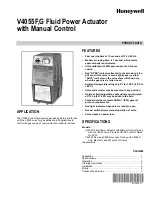
V4055F,G FLUID POWER ACTUATOR WITH MANUAL CONTROL
5
65-0029—01
Mount Actuator On Valve
Check the final position of the valve body to be sure that the
actuator will be in the proper position when mounted on the
valve.
If two smaller size valves are mounted very close together, as
in an Industrial Risk Insurers (formerly F.I.A.) type valve train, it
may be necessary to mount the actuator “off center” to provide
adequate clearance.
Slip the bottom collar of the actuator over the valve bonnet
assembly. Rotate the actuator to the desired position and use a
5/32 inch Allen wrench to tighten the two setscrews securely
(50 to 60 Ib.-in. [5.7 to 6.8 N.m]).
WIRING
Disconnect power supply before making wiring connections to
prevent electrical shock and equipment damage. Wiring must
comply with all applicable electrical codes, ordinances, and
regulations. Wiring to the actuator must be NEC Class 1.
Connect the power supply to terminals 1 and 2 on the V4055
terminal strip. Refer to Fig. 3 for auxiliary switch connections.
For typical system hookups, refer to instructions packed with
device used to control valve.
When all wiring connections are complete, replace the actuator
faceplate.
Fig. 3. External connections to the V4055 actuator.
Adjust The Auxiliary Switch (If Used)
The auxiliary switch is adjustable throughout the stroke of the
actuator. With the switch installed in the actuator, turn the
adjusting screw (Fig. 2) clockwise
to cause the switch to
operate earlier in the stroke or counterclockwise
to
cause the switch to operate later in the stroke.
NOTE: The valve-closed indication switch is not adjustable.
CHECKOUT AND SERVICE
CAUTION
Only a trained, experienced, flame safeguard
control service technician should check out and
service this control.
Checkout
After the installation is complete, cycle the valve several times
with the manual fuel shutoff cock closed before testing the
system in actual operation.
Service
The actuator is not field repairable, except for replacing the
auxiliary switch, valve-closed indication switch, and READY
TO OPEN light. See INSTALLATION section for procedure. Do
not disassemble the valve actuator.
If the actuator should fail to operate properly, replace it.
1.
Turn off the gas supply at the manual shutoff valve
located upstream from the valve(s) being serviced.
2.
Shut off all electrical power to the valve actuator(s).
3.
Mark and disconnect the wires from the actuator termi-
nals. Remove conduit and disengage the damper link-
age assembly (if applicable.
4.
Loosen the two set screws from the valve to lift off the
actuator.
5.
If the actuator is to be replaced and it did not leak
hydraulic fluid, skip to Step 11.
NOTE: It is good practice to inspect the inside of the
valve whenever the actuator is replaced. To do
so, remove the bonnet assembly, inspect the
valve and bonnet. If all is well, proceed to Step 7.
6.
If the actuator leaked hydraulic fluid onto the valve (the
fluid is red), it must be cleaned off from the valve and
bonnet assembly.
a. Wipe off the outer valve body.
b. Remove the valve bonnet bolts and lift off the bonnet.
NOTE: V5055/V5097C and E Valves have additional
internal springs that will push the bonnet up as
the bolts are loosened.
c. Inspect the inside of the valve.
IMPORTANT
If fluid is present on the inside surfaces of the valve
body or bonnet surfaces, the bonnet assembly or
entire valve must be replaced. See Table 3 below for
the bonnet assembly part number.
1
2
3
2
1
1
2
AUXILIARY
SWITCH
L1
HOT
L2
POWER SUPPLY. PROVIDE OVERLOAD PROTECTION AND
DISCONNECT MEANS AS REQUIRED.
SWITCH BETWEEN THESE TWO LEADS IS CLOSED WHEN
VALVE IS SHUT (DE-ENERGIZED).
3 SWITCH BETWEEN THESE TWO LEADS IS OPEN WHEN
VALVE IS SHUT (DE-ENERGIZED).
NO
NC
C
NO
NC
C
PROOF-OF-CLOSURE
SWITCH
2
3
M7334A


























